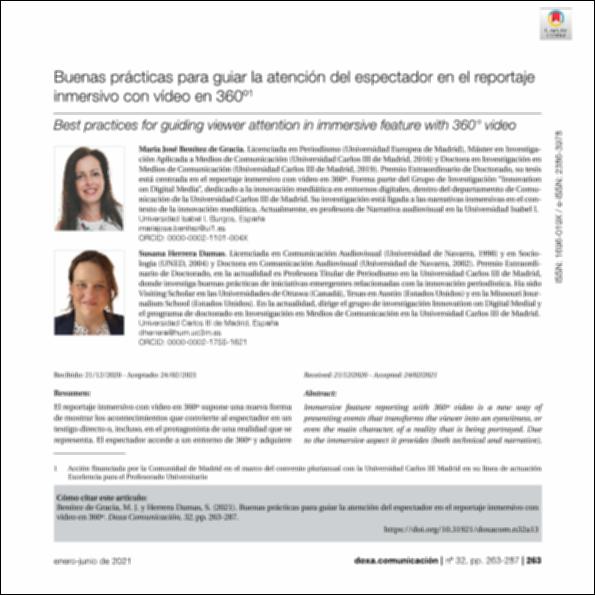Por favor, use este identificador para citar o enlazar este ítem:
http://hdl.handle.net/10637/12792Buenas prácticas para guiar la atención del espectador en el reportaje inmersivo con vídeo en 360º

Ver/Abrir:
Buenas_Benitez_Doxa_Comunicacion_2021_es.pdf
655,76 kB
Adobe PDF
Ver/Abrir:
Best_Benitez_Doxa_Comunicacion_2021_en.pdf
833,85 kB
Adobe PDF
| Título : | Buenas prácticas para guiar la atención del espectador en el reportaje inmersivo con vídeo en 360º Best practices for guiding viewer attention in immersive feature with 360° video |
| Autor : | Benítez de Gracia, María José Herrera Damas, Susana |
| Materias: | Periodismo inmersivo.; Reportaje.; Vídeo en 360º.; Buenas prácticas.; Atención. |
| Resumen : | El reportaje inmersivo con vídeo en 360º supone una nueva forma
de mostrar los acontecimientos que convierte al espectador en un
testigo directo o, incluso, en el protagonista de una realidad que se
representa. El espectador accede a un entorno de 360º y adquiere una perspectiva en primera persona cuyo punto de vista controla
a su voluntad. Sin embargo, en la práctica, este poder se encuentra
con un obstáculo ya que, en numerosas ocasiones, el periodista
no puede dirigir su atención tal y como ocurre en vídeo convencional. El objetivo de esta investigación es identificar una serie de
prácticas que permitan dirigir la atención del espectador sin privarle de la facultad de controlar el punto de vista. Para ello, hemos
realizado una exhaustiva revisión de la literatura sobre el tema, hemos visionado más de mil reportajes de este tipo y hemos llevado
a cabo 9 entrevistas en profundidad con expertos, profesionales y
académicos. Con todo ello, hemos identificado 4 buenas prácticas que pueden contribuir a este fin. El presente estudio justifica
la necesidad de cada una de ellas e ilustra sus posibilidades con
ejemplos reales extraídos de reportajes producidos por medios de
referencia. Immersive feature reporting with 360º video is a new way of presenting events that transforms the viewer into an eyewitness, or even the main character, of a reality that is being portrayed. Due to the immersive aspect it provides (both technical and narrative), the viewer enters a 360° environment and acquires a first-hand perspective with a vantage point that he or she can control at will. In practice, however, this power is hindered by the fact that on many occasions the journalist is unable to direct the viewer’s attention in the same way as can be achieved with conventional video. The aim of this study is to identify a series of practices that allow the viewer’s attention to be directed without depriving him or her of the power to control the point of view. To achieve this purpose, an exhaustive review of the literature on the subject has been conducted, more than a thousand reports of this type have been viewed, and nine in-depth interviews with experts, professionals and academics have been carried out. As a result, we have identified four types of best practices that can help in achieving this purpose. This study justifies the need for each of them and illustrates their potential with reallife examples taken from reports produced by benchmark media. |
| Descripción : | En: Doxa Comunicación: revista interdisciplinar de estudios de comunicación y ciencias sociales. e-ISSN 2386-3978 n. 32, 2021, pp 263-287 |
| URI : | http://hdl.handle.net/10637/12792 |
| Derechos: | http://creativecommons.org/licenses/by-nc-nd/4.0/deed.es |
| Fecha de publicación : | 17-jun-2021 |
| Centro : | Universidad San Pablo-CEU |
| Aparece en las colecciones: | Doxa.Comunicación nº 032 (2021) Monográfico |
Los ítems de DSpace están protegidos por copyright, con todos los derechos reservados, a menos que se indique lo contrario.

